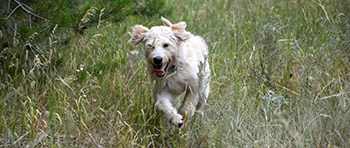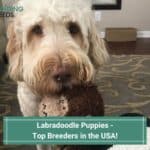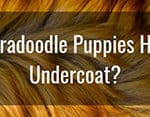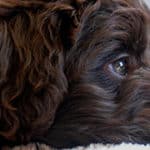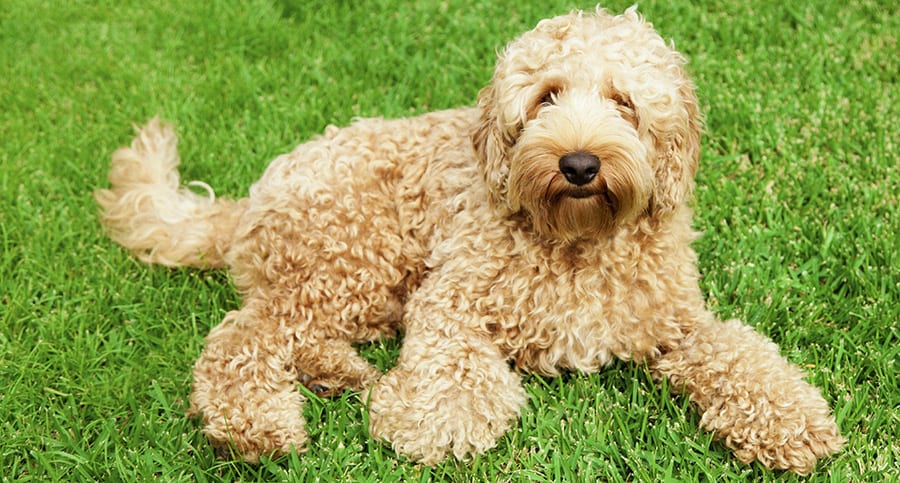
New dog owners are often thrown into a panic the first time they take their pups outside and they start chomping on grass. Whether it’s just a little chewing here and there or they’re making it part of their daily diets, it can be quite concerning. We often wondered why they do it and if it’s bad for them.
So why do Labradoodle puppies chew grass? There isn’t one specific reason why Labradoodle puppies and adult dogs chew on grass. As owners, we’re concerned and worry that it might be bad for them. Experts say it’s very common for dogs to eat grass and they can do it for various reasons.
Possible reasons why they eat grass:
- Upset stomach
- Boredom
- Fulfilling a nutritional need
- Treating intestinal worms
- Flavor
Why Do Puppies Chew on Grass?
Chewing on grass is very common for dogs. A WebMD survey of 49 dogs showed that 79% of the dogs chewed on plants at some time or another, and grass was the most commonly chewed plant. It would appear that dogs chew on grass to relieve a stomachache because we may see our dog chewing on grassing and throwing up afterward. However, we don’t really know if it was the grass that made them throw up in the first place.
Additionally, not every dog will throw up after chewing on grass. It’s almost a catch-22 question because some feel that dog’s chew on grass to make them throw up and feel better while others believe it’s the grass chewing that makes them throw up. Still, others also feel that dogs are incapable of reasoning to the point of feeling that if they chew grass they’ll feel better. So, why exactly do puppies chew on grass?
A dog’s need for fiber often leads them to eat grass. There was a study on a poodle that ate grass every day for a week and vomited each day. The owner put the dog on a high-fiber diet, and that was the end of the poodle eating grass. Some vets also believe that they chew grass to get rid of intestinal worms, which are present in most puppies. It’s also been said that eating grass helps with digestion.
Boredom is another reason why your Labradoodle may eat grass. They’re lying in the grass and just start their never-ending chewing. The bottom line is there are many reasons why puppies chew on grass. Since dogs seldom chew on something they find unpleasant, many dogs may just chew on grass because they like the flavor.
Does Grass Help with a Stomach Ache?
This theory has been going on for almost as long as dogs have been around. Many believe that eating grass does help a stomach because a dog will eat grass, vomit and appear to be back to his lively self again. Yet, many dog owners claim that their dogs eat grass without vomiting.
There is no scientific evidence to prove if it helps with a stomachache or has any effect whatsoever. Another fact to remember is that your puppy (and all dogs) evolved from canines, like wolves, which ate grass-eating animals such as deer, rabbits, and mice, among others. This could be where their appeal for the taste of grass originated.
Is Grass Bad for Labradoodles?
Because no one has really determined why dogs eat grass, it’s hard to say if it’s bad for them. Like most of the salad greens eaten by humans, grass is actually very healthy. It provides the dog with fibers, vitamins, protein, and other important nutrients.
Many lawns or fields that appear to be grass have actually been sprayed with insecticides, pesticides and other chemicals. These chemicals can be very dangerous for dogs. If your Labradoodle puppy doesn’t seem to be affected by eating grass, and you know it’s only grass, there really isn’t any reason to be concerned.
When Should You Be Concerned About Grass Consumption?
Even if you’ve accepted that your dog likes to eat grass, you’re probably still going to have some concerns. Is it making them throw up? Are they eating it for the sole purpose to make themselves throw up? How much is too much? These questions can all usually be answered by observing the dog’s behavior particularly after the dog has eaten grass.
If your Labradoodle pup eats grass on a regular basis and seems otherwise happy and healthy, it’s probably safe to say it’s not harming the dog. On the other hand, if the dog seems to be out of sorts lately and is increasing his or her intake of grass, a trip to the veterinarian might be in order. This could be the start of an underlying gastrointestinal problem.
How Can I Stop My Dog From Eating Grass?
Even if you’re almost convinced that eating grass is not harmful to your dog, you may still not be comfortable with the idea and wonder how to stop it. Unless you’re with the dog every second that the dog’s outdoors, it can be difficult. If your dog is only outdoors with you, you do have an advantage. Here are some ways you may be able to stop your dog from eating grass.
- Have your vet check out your dog to make sure there is no health issue going on.
- In case your dog is eating grass for dietary needs, increasing the dog’s fiber intake may help.
- Dogs often eat grass out of boredom, so increase the amount of exercise your dog gets every day.
- Correct the dog gently by saying “no” each time you see him eating grass.
- Replace the grass with a healthy snack you know your dog likes.
What Other Plants are Harmful to My Labradoodle dog?
Now that we’ve gone over the ins and outs of eating grass, you’re probably wondering about other plants. There are so many plants everywhere both indoors and outdoors. While it’s true that dogs safely consumed many green plants years ago, we have many plants today that weren’t around back then.
For some reason, dogs just can’t seem to walk past a plant without sniffing it and maybe taking a bite or two. Some of these can be very harmful to the dog. You may have some of these in your flowerbed without realizing the potential danger.
- Autumn Crocus –These can cause seizures, diarrhea, vomiting, burning in the mouth and kidney or liver failure. While the entire plant is harmful, the bulb is the most toxic.
- Tulip – Eating this can cause nausea, excessive drooling, and serious oral irritation. The bulb is the most toxic part of the plant.
- Amaryllis – This poisonous Easter plant can cause depression, diarrhea, vomiting, anorexia, tremors, abdominal pain, and excessive salivation.
- Autumn Crocus – These can cause seizures, diarrhea, vomiting, burning in the mouth and kidney or liver failure. While the entire plant is harmful, the bulb is the most toxic.
- Azalea – Eating even a few leaves of these plants can cause diarrhea, vomiting, oral irritation, decreased blood pressure, coma, and even death.
- Daffodil – Eating this plant can cause abdominal pain, diarrhea, vomiting, convulsions and a serious drop in blood pressure. The bulb is the most toxic part.
- Cyclamen – This household plant is poisonous and can cause heart abnormalities, oral irritation, seizures, diarrhea, and death.
- Oleander – This flowering shrub contains extremely toxic cardiac glycosides that can cause vomiting, incoordination, bloody diarrhea, muscles tremors, and fatal heart abnormalities.
- Kalanchoe – This common houseplant can cause diarrhea, vomiting and even heart arrhythmias if eaten.
- Dieffenbachia – Eating this common household plant can cause burning in the mouth, difficulty swallowing, vomiting, and oral irritation.
Related Questions
Why do puppies chew on everything?
This is probably the million-dollar question. Their desire to chew starts the moment they’re born and continues for a long time. The main reason is that their gums hurt from teething and chewing something, and they don’t care what it is, relieves the pain. Providing your Labradoodle with appropriate chew toys can ensure that they don’t put something harmful in their little mouths.
What are some good chew toys for puppies?
There are so many good chew toys for puppies available on the market today. Some popular vet-approved chew toys are:
- Nylabone Just for Puppies Ring Bone
- Kong Puppy Toy
- Nylabone Romp ‘N Chomp Bone Dog Treat and Chew Toy
- Tuffy’s Ultimate Gear Ring
- Benebone Wishbone Chew Toy
Avoid chew toys that are not BPA-free, can be torn into pieces, have squeakers inside and are not size and age-appropriate. As much as dogs love rawhide chews and bones, they can be harmful to your dog because they pose a risk of choking.
In Summary….
If you find your Labradoodle puppy chewing on grass, don’t fret…. at least not immediately. Dogs are very resilient and often can resolve their own issues, such as bellyaches. If your Labradoodle puppy seems otherwise fine, it might just be nibbling as a happy pastime. A game of fetch would probably do a great job of distracting him!

